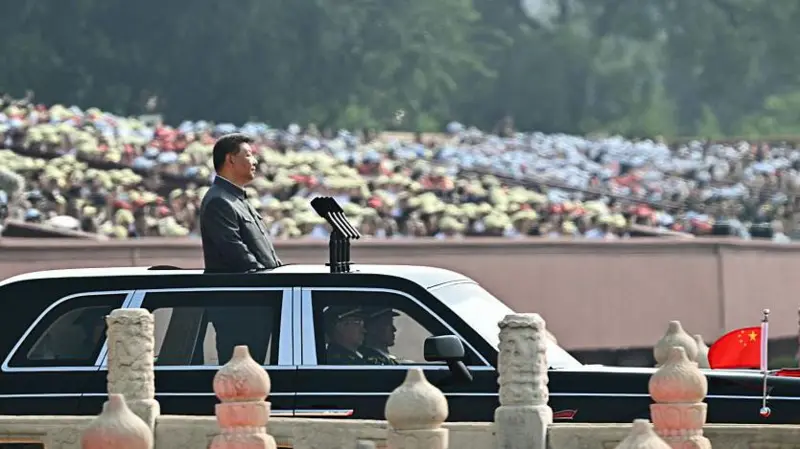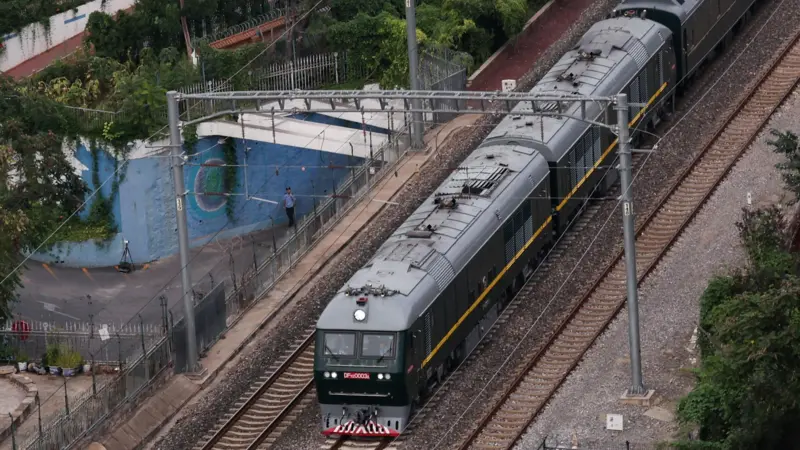
Opening Ceremony and Xi Jinping’s Speech
On the morning of September 3, China held a grand ceremony marking the 80th anniversary of the victory in the Chinese People’s War of Resistance Against Japanese Aggression and the World Anti-Fascist War.
President Xi Jinping delivered a keynote speech after the flag-raising ceremony, stressing the heroic sacrifices of the Chinese people during the war and calling on the People’s Liberation Army (PLA) to accelerate the building of a world-class military, safeguard national sovereignty and territorial integrity, and contribute to world peace and development.
Unlike his 2015 “9·3” speech, where Xi emphasized China’s policy of non-hegemony and announced a 300,000 troop cut, this year’s remarks were relatively restrained, focusing more on continuity and military modernization.
Unexpected Change in Parade Command
Traditionally, the military commander of the host unit presides over the parade. This year, however, Han Shengyan, Air Force Commander of the Central Theater Command, acted as parade commander instead of the Central Theater Commander Wang Qiang—breaking long-established protocol.
Observers noted that Wang Qiang’s absence extended beyond the parade: he was also missing from the August 1 Army Day celebrations. This unusual change has fueled speculation amid the ongoing turbulence in China’s military leadership.
Diplomatic Stage: Putin, Kim Jong Un, and Seating Arrangements
Xi Jinping has long used military parades as a diplomatic platform. Ten years ago, Russian President Vladimir Putin and then-South Korean President Park Geun-hye occupied the seats of honor beside him. This year, Putin was once again placed in the top foreign guest position, but the second seat was given to North Korea’s Kim Jong Un.
The seating lineup also reflected major changes: Xi stood flanked by Putin and Kim, while past Chinese leaders such as Jiang Zemin (deceased) and Hu Jintao (absent) did not appear. Instead, figures like Wen Jiabao, Wang Qishan, Zhang Gaoli, Jia Qinglin, and Liu Yunshan were present.
Kim Jong Un’s attendance drew international attention, marking the first time since 1959 (Kim Il Sung’s visit) that a North Korean leader stood on Tiananmen alongside Chinese leaders during a parade. Analysts noted the rare image of China, Russia, and North Korea’s leaders together—something not seen even during the Korean War era.

PLA Shakeups and Leadership Purge
The parade took place against the backdrop of a major reshuffle in the PLA. High-ranking generals close to Xi have recently faced investigations or disappeared from public view.
-
He Weidong, Vice Chairman of the Central Military Commission (CMC), a long-time Xi ally, has been absent from official activities.
-
Miao Hua, responsible for political work, has been investigated for serious violations.
-
Li Shangfu, former Defense Minister and CMC member, is also under probe.
These developments have left three of the CMC’s seven seats vacant. Additionally, absences of senior officers like Wang Kai (Tibet Military Commander) and Fang Yongxiang (CMC Office Director) during Xi’s Tibet trip in August sparked further speculation of internal purges.

Taiwan’s Divided Presence
Taiwan’s participation drew controversy. The government in Taipei had barred officials from attending, but former KMT chairwoman Hung Hsiu-chu appeared on Tiananmen’s viewing platform, emphasizing that the anti-Japanese war was a “shared national history.” She was joined by leaders of other pro-unification parties such as the New Party and Labor Party.
This move sparked sharp criticism from pro-independence voices in Taiwan, who accused participants of undermining national sovereignty and called for sanctions against them.
Weapons Showcase: Modernization and Drones
Speculation surrounded whether China would unveil next-generation weapons, including the H-20 stealth bomber or the DF-51 intercontinental missile. However, officials clarified that only current active-duty equipment was included in the parade.
Notably, the PLA highlighted drones and anti-drone systems, reflecting lessons from the ongoing Russia-Ukraine conflict. These systems have evolved from tactical supplements to central battlefield assets, enabling reconnaissance, strike, electronic warfare, and logistical disruption.
Post time: Sep-03-2025






